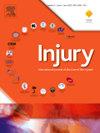Risk factors associated with surgical site infection after internal fixation of ballistic diaphyseal fractures
IF 2.2
3区 医学
Q3 CRITICAL CARE MEDICINE
Injury-International Journal of the Care of the Injured
Pub Date : 2025-03-25
DOI:10.1016/j.injury.2025.112302
引用次数: 0
Abstract
Objectives
Management of civilian gunshot wound (GSW) fractures is controversial, with limited data on infection risk and controversy regarding treatment. While lower-energy GSWs are considered lower risk than other open fractures, complication rates remain high. This study aimed to identify risk factors for infection in operatively treated ballistic fractures.
Methods
After institutional review board approval, we identified 2136 GSW-related fractures from 01/01/2012 to 12/31/2021 at our level one trauma center. After excluding articular, hand, foot, injuries through viscera and pre-existing infections, 110 patients with 125 long bone fractures were retrospectively reviewed. The primary outcome was infection requiring reoperation. Statistical analysis included Mann-Whitney U, T-tests, Pearson's Chi-square, ROC analysis, and Youden's index.
Results
Sixteen patients (14.5 %) developed infections requiring reoperation. The cohort had a mean age of 30 years, 90 % male, BMI 27.7 ± 7.2 kg/m², Charlson comorbidity index <1, and 37 % smokers. Increased infection risk was associated with admission glucose (p < 0.001) and length of stay (p < 0.001). Admission glucose >156 mg/dL increased odds of infection sixfold (OR 6.1, 95 % CI 2.0–19.0), while a hospital stay >10 days increased odds of infection twentyfold (OR 21.1, 95 % CI 5.3–82.7). Transfusion (p = 0.004), abdominal (p = 0.007), and chest trauma (p = 0.010) also correlated with infection risk. No significant associations were found with nicotine use, Charlson comorbidity index, or BMI.
Conclusions
Operatively treated long bone injuries had a 14.5 % infection rate. Elevated admission glucose and prolonged hospital stay significantly increased infection risk, particularly in polytrauma patients. Identifying high-risk patients, promoting early mobilization, and ensuring glycemic control may help reduce infections. Further research is needed to develop targeted prevention strategies.
Level of evidence
3 (Retrospective Comparative Study)
弹道骺端骨折内固定术后手术部位感染的相关风险因素
本文章由计算机程序翻译,如有差异,请以英文原文为准。
求助全文
约1分钟内获得全文
求助全文
来源期刊
CiteScore
4.00
自引率
8.00%
发文量
699
审稿时长
96 days
期刊介绍:
Injury was founded in 1969 and is an international journal dealing with all aspects of trauma care and accident surgery. Our primary aim is to facilitate the exchange of ideas, techniques and information among all members of the trauma team.

 求助内容:
求助内容: 应助结果提醒方式:
应助结果提醒方式:


